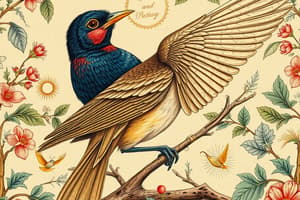Podcast
Questions and Answers
Match the following behavioral aspects with their relevant categories:
Match the following behavioral aspects with their relevant categories:
ritualization = Social behavior imprinting = Development of behavior circadian clocks = Biological rhythms pheromones = Animal Communication
Match the types of behavior with their respective explanations:
Match the types of behavior with their respective explanations:
innate = Behavior that is genetically programmed conditioned = Behavior learned through experience habituation = Decrease in response to a stimulus over time complex behaviour patterns = Behavior that involves a combination of innate and learned components
Match the following aspects of social organization with their definitions:
Match the following aspects of social organization with their definitions:
dominance = Establishment of an individual's status in a group parental care = Investment of parents in the growth and development of offspring sexual behaviour = Behaviors associated with mating and reproduction kinship = Social bonds based on common ancestry or marriage
Match the following mechanisms of behavior with their explanations:
Match the following mechanisms of behavior with their explanations:
Explain the concept of imprinting and provide an example of a species that exhibits this behavior.
Explain the concept of imprinting and provide an example of a species that exhibits this behavior.
What are the different types of social behavior and provide an example for each?
What are the different types of social behavior and provide an example for each?
Describe the role of biological rhythms in animal behavior and provide an example of a biological rhythm.
Describe the role of biological rhythms in animal behavior and provide an example of a biological rhythm.
Discuss the importance of animal communication and provide examples of different communication methods.
Discuss the importance of animal communication and provide examples of different communication methods.
Flashcards are hidden until you start studying




